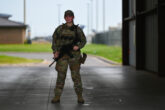September 17, 2021
Closing the Gaps Between Servicemembers and the American Public
We have been a nation at war — sort of. Due to the longest wars in American history being shouldered by a tiny percentage of the population, the vital civil-military relationship has become strained since 9/11.
Following the 9/11 attacks, military enlistments increased only marginally during the remainder of 2001, and stabilized after a few months. At the time, the military services reported a temporary spike in enlistment inquiries, yet few followed through. Recent events, such as a large military presence monitoring the June 2020 protests across the country, politicization of the armed forces leading up to the 2020 presidential election, and the response of the Department of Defense during the Jan. 6 attack on the US Capitol, indicate that there is a civil-military disconnect at the highest levels. Yet, there is a deeper divide, between the military and the American public, indicating a breakdown between us and those who serve us. Two groups serve as good examples of this breakdown: veterans and military families.
For military families, the civil-military relationship since 9/11 has split them between two worlds.
Post-9/11 veterans have some significant differences compared to previous generations of veterans. Those who served in these past 20 years are more likely than the general veteran population to have been deployed, seen combat, and experienced emotional trauma. In addition to their in-service experiences, the transition back to civilian life is more isolated than the experience of pre-9/11 veterans, as few in their communities and workplaces share in the experience of military service. A common complaint from veterans seeking civilian employment is an employer market unfamiliar with the military experience, a societal change from previous generations of veterans. A follow-on effect to the isolation of the military experience in the US has been the perception of the general public by veterans, who consider themselves to be more patriotic than other Americans.
Read the full article and more from Inkstick.
More from CNAS
-
National Security Human Capital Program
Short SupplyExecutive Summary The U.S. military faces a critical challenge: Fewer young Americans are willing to serve, and fewer adults are encouraging them to do so. Because of delibera...
By Katherine L. Kuzminski & Taren Sylvester
-
National Security Human Capital Program
Defending the Army’s Command Assessment ProgramThe concept for CAP — developed during the first Trump administration — benefited from the guidance, input and oversight from the foremost scholar and practitioner on military...
By Katherine L. Kuzminski
-
National Security Human Capital Program
‘Women Don’t Just Achieve…They Excel’: Fmr. Marine Corps Attack PilotDr. Kyleanne Hunter, former Marine Corps attack pilot and CEO of Iraq & Afghanistan Veterans of America, says “women are the fastest growing group of veterans” and “the fastes...
By Dr. Kyleanne Hunter
-
National Security Human Capital Program
A Workforce Strategy for America’s Shipbuilding FutureThe future of American maritime dominance will not be determined solely by the number of ships launched or contracts signed, but rather by the strength and sustainability of t...
By Katherine L. Kuzminski & Laura Schmiegel




